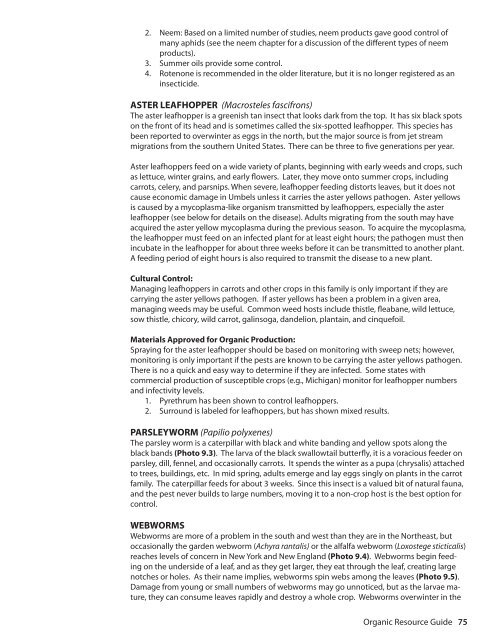Resource Guide for Organic Insect and Disease ... - Cornell University
Resource Guide for Organic Insect and Disease ... - Cornell University
Resource Guide for Organic Insect and Disease ... - Cornell University
Create successful ePaper yourself
Turn your PDF publications into a flip-book with our unique Google optimized e-Paper software.
2. Neem: Based on a limited number of studies, neem products gave good control of<br />
many aphids (see the neem chapter <strong>for</strong> a discussion of the different types of neem<br />
products).<br />
3. Summer oils provide some control.<br />
4. Rotenone is recommended in the older literature, but it is no longer registered as an<br />
insecticide.<br />
ASTER LEAFHOPPER (Macrosteles fascifrons)<br />
The aster leafhopper is a greenish tan insect that looks dark from the top. It has six black spots<br />
on the front of its head <strong>and</strong> is sometimes called the six-spotted leafhopper. This species has<br />
been reported to overwinter as eggs in the north, but the major source is from jet stream<br />
migrations from the southern United States. There can be three to five generations per year.<br />
Aster leafhoppers feed on a wide variety of plants, beginning with early weeds <strong>and</strong> crops, such<br />
as lettuce, winter grains, <strong>and</strong> early flowers. Later, they move onto summer crops, including<br />
carrots, celery, <strong>and</strong> parsnips. When severe, leafhopper feeding distorts leaves, but it does not<br />
cause economic damage in Umbels unless it carries the aster yellows pathogen. Aster yellows<br />
is caused by a mycoplasma-like organism transmitted by leafhoppers, especially the aster<br />
leafhopper (see below <strong>for</strong> details on the disease). Adults migrating from the south may have<br />
acquired the aster yellow mycoplasma during the previous season. To acquire the mycoplasma,<br />
the leafhopper must feed on an infected plant <strong>for</strong> at least eight hours; the pathogen must then<br />
incubate in the leafhopper <strong>for</strong> about three weeks be<strong>for</strong>e it can be transmitted to another plant.<br />
A feeding period of eight hours is also required to transmit the disease to a new plant.<br />
Cultural Control:<br />
Managing leafhoppers in carrots <strong>and</strong> other crops in this family is only important if they are<br />
carrying the aster yellows pathogen. If aster yellows has been a problem in a given area,<br />
managing weeds may be useful. Common weed hosts include thistle, fleabane, wild lettuce,<br />
sow thistle, chicory, wild carrot, galinsoga, d<strong>and</strong>elion, plantain, <strong>and</strong> cinquefoil.<br />
Materials Approved <strong>for</strong> <strong>Organic</strong> Production:<br />
Spraying <strong>for</strong> the aster leafhopper should be based on monitoring with sweep nets; however,<br />
monitoring is only important if the pests are known to be carrying the aster yellows pathogen.<br />
There is no a quick <strong>and</strong> easy way to determine if they are infected. Some states with<br />
commercial production of susceptible crops (e.g., Michigan) monitor <strong>for</strong> leafhopper numbers<br />
<strong>and</strong> infectivity levels.<br />
1. Pyrethrum has been shown to control leafhoppers.<br />
2. Surround is labeled <strong>for</strong> leafhoppers, but has shown mixed results.<br />
PARSLEYWORM (Papilio polyxenes)<br />
The parsley worm is a caterpillar with black <strong>and</strong> white b<strong>and</strong>ing <strong>and</strong> yellow spots along the<br />
black b<strong>and</strong>s (Photo 9.3). The larva of the black swallowtail butterfly, it is a voracious feeder on<br />
parsley, dill, fennel, <strong>and</strong> occasionally carrots. It spends the winter as a pupa (chrysalis) attached<br />
to trees, buildings, etc. In mid spring, adults emerge <strong>and</strong> lay eggs singly on plants in the carrot<br />
family. The caterpillar feeds <strong>for</strong> about 3 weeks. Since this insect is a valued bit of natural fauna,<br />
<strong>and</strong> the pest never builds to large numbers, moving it to a non-crop host is the best option <strong>for</strong><br />
control.<br />
WEBWORMS<br />
Webworms are more of a problem in the south <strong>and</strong> west than they are in the Northeast, but<br />
occasionally the garden webworm (Achyra rantalis) or the alfalfa webworm (Loxostege sticticalis)<br />
reaches levels of concern in New York <strong>and</strong> New Engl<strong>and</strong> (Photo 9.4). Webworms begin feeding<br />
on the underside of a leaf, <strong>and</strong> as they get larger, they eat through the leaf, creating large<br />
notches or holes. As their name implies, webworms spin webs among the leaves (Photo 9.5).<br />
Damage from young or small numbers of webworms may go unnoticed, but as the larvae mature,<br />
they can consume leaves rapidly <strong>and</strong> destroy a whole crop. Webworms overwinter in the<br />
<strong>Organic</strong> <strong>Resource</strong> <strong>Guide</strong> 75







